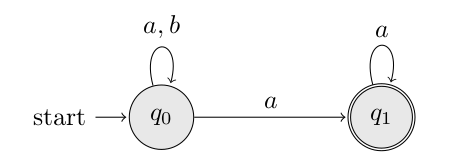A ω-regular language inclusion checker.
bait is an ω-regular language inclusion checker which relies on an algorithm
derived from Abstract Interpretation techniques.
The tool accepts as input two
ω-regular languages represented as
Büchi automata and outputs
whether the inclusion holds or not.
The automata are represented with the the .ba format.
bait is the implementation of an algorithm presented at the conference CONCUR in 2021.
A link to the article is given here.
- Java 8+
Use ./gradlew build to build bait.
The easiest way to run bait is to execute the bait.jar file with java -jar bait.jar -a path/to/A.ba -b path/to/B.ba.
You can download it from the release page.
Alternatively, you can build the jar file with:
git clone https://github.com/parof/bait
cd bait
./gradlew installDist
This command will build the executable .jar file in build/libs.
Once you built the executable you can run:
java -jar build/libs/bait.jar -a path/to/A.ba -b path/to/B.ba
You can also run bait using gradlew run:
./gradlew run --args='-a /path/to/A.ba -b /path/to/B.ba'
Run with argument --help to see the all the available options.
The input automata must be specified in the .ba format.
The official description of the format, written by its authors, has been archived
here.
Other tools, for example RABIT,
accept the same input format.
One .ba file must respect the following specification:
(initial state)
...
(transitions)
...
(accepting states)
Observe that automata in .ba format have only one initial state.
One state is simply a sequence of characters. Here there are some examples:
state
state1
a
iB
[0][1][2]
Observe that [0][1][2] is a single state: the squared brackets are just part
of the name of the state and they don't have a semantic meaning.
Additionally, we require that the states don't include in the names the
strings , or ->, because they will be used to define the transitions.
One transition is defined as
symbol,firstState->secondState
where symbol is a sequence of characters, and firstState and secondState are states.
Similarly to the states, the symbols can't contain -> or , as substrings.
Here there are some examples of valid transitions:
a,s1->s2
1,s->s'
sym,[0][0]->[0][1]
If no initial state is specified, the first state in the first transition of the automaton is considered to be the initial one. If no final state is specified, then each state in the automaton is considered to be final.
Consider the following automaton:
It can be represented in the .ba format as:
q0
a,q0->q1
b,q1->q1
c,q1->q0
q1
Observe that since the initial state is also the first state of the first transition, and then we can omit to specify it:
a,q0->q1
b,q1->q1
c,q1->q0
q1
We want to compute whether the inclusion holds between the following automata:
The first automaton A is represented in the .ba format as:
a,q0->q0
b,q0->q0
a,q0->q1
a,q1->q1
q1
While the second automaton B is represented in the .ba format as:
a,q0->q1
b,q1->q0
q1
You can finally compute whether the inclusion holds or not using bait.jar
with the following command:
java -jar bait.jar -a A.ba -b B.ba
This command will give you the following output:
Since the language of A is (a+b)*aω and the language of B is (ab)ω the
inclusion doesn't hold, and then False is correctly returned.
In the test-automata directory there are some examples of automata in the
.ba format.
We benchmarked bait with a large set of automata, and they can be found in a
separate repository:
https://github.com/parof/buchi-automata-benchmark.




